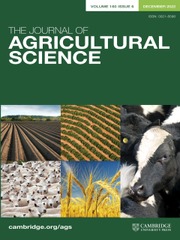No CrossRef data available.
Article contents
Employing direct-fed microbial and hydrolysed yeast to modulate in vitro ruminal fermentation parameters of medium- and low-quality forages
Published online by Cambridge University Press: 02 July 2025
Abstract
This study evaluated the effects of combining Bacillus species with hydrolysed and inactive Torula yeast on rumen fermentation of tropical forages in vitro. Exp. 1 assessed different combinations of direct-fed microbials (DFM) and hydrolysed/inactive yeast on the ruminal fermentation of Urochloa brizantha hay in a randomised block design (3×3 factorial scheme). Treatments included: 1) Negative control, no DFM inclusion (NC); 2) B. subtilis and B. licheniformis (SL); 3) B. subtilis, B. licheniformis, B. amyloliquefaciens and B. coagulans (SLAC); 4) Hydrolysed Torula yeast (HY); 5) dry inactive Torula yeast (IY); 6) B. subtilis, B. licheniformis and dry inactive Torula yeast (SL+IY); 7) B. subtilis, B. licheniformis and hydrolysed Torula yeast (SL+HY); 8) B. subtilis, B. licheniformis, B. amyloliquefaciens, B. coagulans and dry inactive Torula yeast (SLAC+IY) and 9) B. subtilis, B. licheniformis, B. amyloliquefaciens, B. coagulans and hydrolysed Torula yeast (SLAC+HY). Bacillus and yeast interaction affected the total short-chain fatty acids (SCFA) and SCFA profile. In treatments without Bacillus, IY resulted in higher isovalerate compared to treatments without yeast (NC). The no yeast treatment also had lower isovalerate concentration than other treatments (HY, IY). Exp. 2 and Exp. 3 evaluated NC, SL, SLAC, SL+HY and SLAC+IY plus SLAC+HY in low- and medium-quality forage. For low-quality forage, SLAC+IY + SLAC+HY had the highest NH3-N concentration, while SL+HY yielded the highest total SCFA. In medium-quality forage, SL+HY showed the highest total SCFA. The combination of Bacillus species and HY may enhance total SCFA and NH3-N in the rumen, improving nutrient utilisation in grazing beef cattle.
Information
- Type
- Animal Research Paper
- Information
- Copyright
- © The Author(s), 2025. Published by Cambridge University Press
Footnotes
Current address: AgNext, Department of Animal Sciences, Colorado State University, Fort Collins, CO 80523, USA


